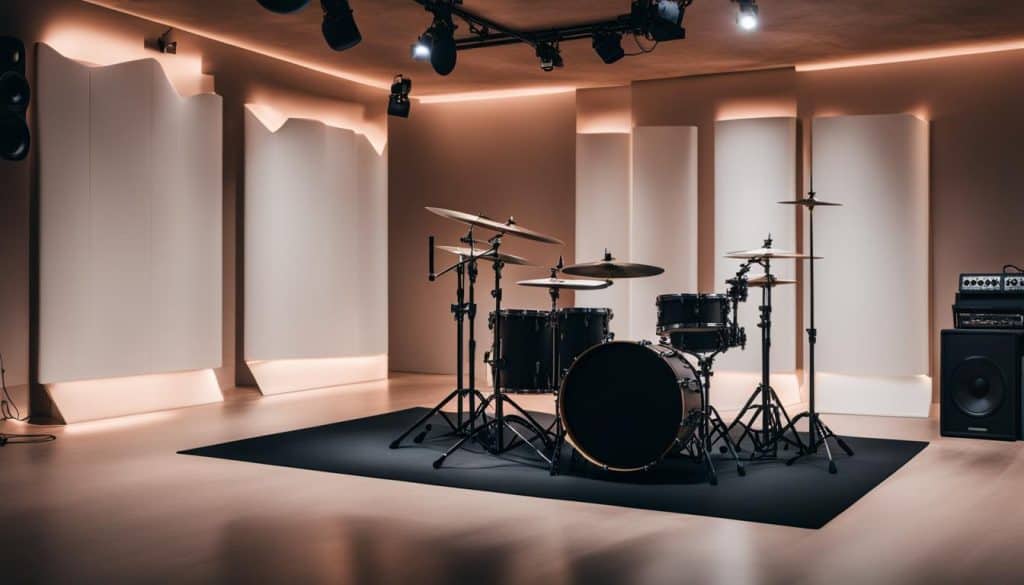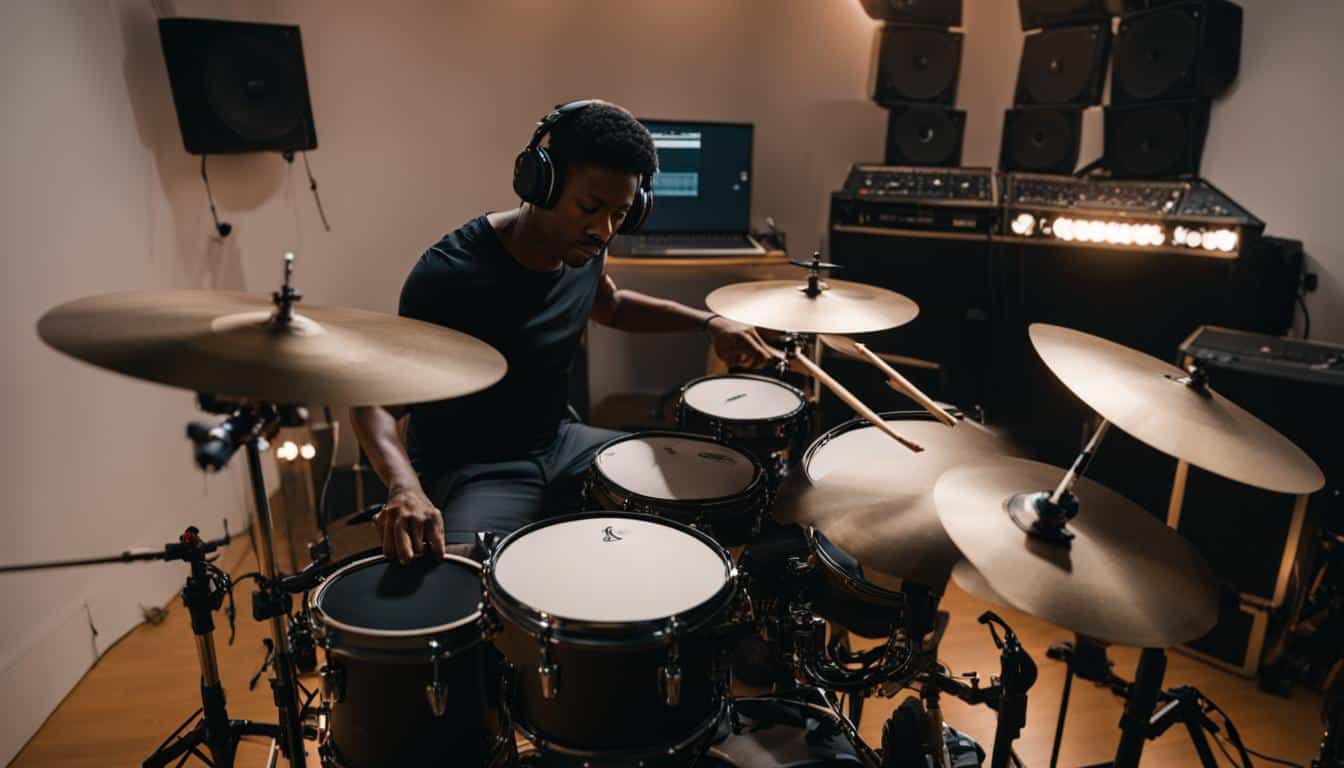As a drummer, you know how important it is to practice consistently to improve your skills. However, sometimes you may not have the luxury of playing your drums as loudly as you’d like due to noise restrictions or living in close proximity to others. This is where the concept of “silent drumming” comes in.
Silent drumming involves practicing with headphones on electric kits, allowing you to enjoy the benefits of drumming without disturbing others. With silent drumming, you can practice at any time of the day or night and retain the authenticity of live drumming.
Electric drum kits have revolutionized drumming practice by creating a quieter and more portable alternative to acoustic drums. With advancements in technology, electronic kits now provide realistic drum sounds and a range of customization options, enabling drummers to simulate the feel and sound of a traditional drum set.
So, if you’re looking for a way to practice your drumming skills without disturbing others or just want to switch things up, silent drumming with headphones on electric kits may be the solution you’ve been looking for.
< class="wp-block-separator has-alpha-channel-opacity"/>The World of Silent Drumming
Silent drumming has come a long way since its inception. The evolution of silent drumming has seen electric drum kits take center stage, allowing drummers to practice without disturbing others.

The importance of silent drumming cannot be overstated, especially in today’s world, where more and more people are living in shared spaces.
Before electric drum kits, drummers had limited options when it came to silent practice. One option was to use practice pads, which only provided a limited amount of resistance and did not provide the same feel as actual drums.
Another option was to use mutes on acoustic drums, although this method also had its limitations. Electric drum kits have revolutionized the way drummers practice, providing a realistic drumming experience with the added benefit of volume control.
“Silent practice helps you to develop your timing, precision, and dynamic range without the distractions that can occur in a noisy setting.”
Drumming techniques play a crucial role in silent drumming. Without proper technique, drummers cannot achieve the same level of proficiency as they would if they were playing on acoustic drums.
However, with the right practice routine and techniques, drummers can develop their skills and become more proficient in their playing.
Electric drum kits come with a variety of features and components that make silent practice possible. The essential components of an electric drum kit include the drum pads, cymbal pads, and drum sound module.
The drum sound module is a vital component as it provides the drum sounds and kits that mimic the sound of an acoustic drum kit.
The drum sound module allows for a wide range of drum sounds and kits. Some drum sound modules come with preset drum kits, while others allow for custom drum configurations. The variety of drum sounds and kits available allows drummers to experiment with different sounds and develop their playing style.
Overall, silent drumming provides numerous benefits for drummers. It fosters concentration and precision, which in turn leads to improved drumming proficiency. In the next section, we will discuss how to set up a conducive practice environment for silent drumming.
< class="wp-block-separator has-alpha-channel-opacity"/>Setting up Your Silent Practice Space
Creating a conducive environment for silent drumming is crucial to achieving a productive and effective practice session. Here are some tips to help you set up your space:
Dedicated Practice Area
Designate a specific area for your electric drum kit and headphones to minimize distractions and maximize focus during practice. Ideally, this area should be isolated from external noise and activity.
Soundproofing
While electric drum kits are quieter than acoustic ones, they can still produce noise that may disturb others in your vicinity. Consider soundproofing your practice area with sound-absorbing panels, rugs, or curtains to minimize noise output.
Essential Components of Electric Drum Kits
An electric drum kit comprises several essential components that work together to generate sound. These include:
| Component | Description |
|---|---|
| Drum pads | These are the surfaces on which you hit your drumsticks. They typically have built-in sensors that transmit the impact to the sound module. |
| Sound module | This is the brain of your electric drum kit. It generates sounds based on the input it receives from the drum pads and cymbals. |
| Cymbals | Electric drum kits have electronic cymbals that generate sound when hit. They usually have choke and bell functionalities. |
| Kick pedal | The kick pedal is used to generate the bass drum sound. It’s usually connected to the sound module via cable. |
| Hi-hat controller | The hi-hat controller is a foot pedal that controls the hi-hat cymbal sound. It’s also connected to the sound module via cable. |
Make sure all components are properly connected and in good working condition before starting your practice session.

“The right practice environment can make all the difference in your drumming performance.”
With these tips, you can create a conducive environment for silent drumming practice and ensure a productive and enjoyable session. By having all essential components in place, you can achieve the best possible sound quality and focus on improving your drumming skills.
< class="wp-block-separator has-alpha-channel-opacity"/>The Power of Drum Sound Modules
If you’re new to silent drumming, you might be wondering what drum sound modules are and why they are important. Drum sound modules, also known as drum modules or sound modules, are electronic devices that produce a variety of drum sounds and kits.
The role of drum sound modules in silent drumming is paramount. They enable you to play different drum sounds and kits on your electric drum kit without disturbing your neighbors, family members, or roommates. You can practice using headphones while enjoying the same sound quality found in acoustic drumming.
The variety of drum sounds and kits available from drum sound modules is extensive, allowing you to customize your sound and replicate the feel of a real drum kit. Whether you’re playing rock, jazz, hip-hop, or any other genre, you can find a kit that suits your style and preferences.
Drum sound modules come in two main types: preset drum kits and custom drum configurations. Preset drum kits are factory-programmed and designed to replicate the sound and feel of specific drum kits, such as a Ludwig or Gretsch kit.
Custom drum configurations, on the other hand, allow you to create your own unique sound by selecting individual drum sounds and combining them into your own kit.
Using a drum sound module is straightforward and user-friendly. Simply connect your electric drum kit to the module using a standard MIDI cable and start playing. You can adjust the volume, tone, and other parameters to achieve your desired sound.
Whether you’re a beginner or an experienced drummer, incorporating drum sound modules into your silent practice routine will enhance your drumming experience and take your skills to the next level.
< class="wp-block-separator has-alpha-channel-opacity"/>Choosing the Right Headphones
When it comes to silent drumming, selecting the right headphones is crucial. Not all headphones are suitable for drumming, and using the wrong ones can cause more harm than good. Here are some factors to consider when choosing headphones for silent practice:
Noise Isolation
Noise isolation is an essential feature for drumming headphones. It blocks out external sounds, allowing you to focus on your drumming. Look for headphones that offer a high level of noise isolation to ensure a distraction-free practice session.
Sound Quality
Another important factor to consider is sound quality. You want headphones that deliver clear and accurate sound, so you can hear all the nuances of your drumming. Avoid headphones with exaggerated bass or treble, as they can mask important details in your playing.
Additionally, consider purchasing headphones with a closed-back design. These headphones prevent sound leakage, ensuring that only you can hear your drumming.

Investing in high-quality headphones can significantly improve your silent drumming experience. Don’t compromise on noise isolation and sound quality, as they are essential to enhance your practice sessions.
< class="wp-block-separator has-alpha-channel-opacity"/>Silent Drumming Techniques
Practicing with headphones on an electric drum kit requires specific drumming techniques to get the best out of the experience. Keep the following tips in mind to help you improve your skills while maintaining precision, dynamics, and timing.
Use Proper Wrist Technique
Using proper wrist technique while playing can help you achieve a good balance of power and control. It’s essential to keep your wrists relaxed and use a light grip to avoid any unnecessary tension and fatigue. Try to use your wrists to generate most of the power, rather than your arms, for more precise movements.
Focus on Dynamics
Dynamics are crucial in drumming, especially when playing on an electric kit with headphones. Experiment with different sounds and levels of volume to add depth to your playing. You can also practice incorporating accents, flams, and ghost notes to create more textured and interesting rhythms.
Work on Timing
Timing is everything in drumming, and silent practice is no exception. It can be challenging to maintain good timing without the natural acoustic feedback of an acoustic kit, but playing along with a metronome or drum machine can help. Start slowly and gradually increase the tempo to challenge yourself and build your timing skills.
Aim for Precision
Precision is vital when practicing on an electric kit with headphones. Pay close attention to your strokes and aim to hit each drum or cymbal in the same spot every time. Consistency is key, and practicing with precision will help you improve your overall drumming proficiency.
By using proper drumming techniques, you can make the most of your silent practice sessions. Focus on dynamics, timing, and precision to achieve a better balance of power and control in your playing.

Benefits of Silent Drumming
If you’re a drummer looking for a way to practice without disrupting your neighbors or roommates, silent drumming is the solution. But did you know that this method of practicing has more benefits than just noise reduction? In this section, we’ll explore the advantages of silent practice.
Improved Concentration
One of the primary benefits of silent drumming is that it allows you to focus on your playing without distractions. By eliminating external noise, you’re better able to concentrate on the intricacies of your drumming techniques. This heightened focus can help you refine your skills and improve your overall proficiency.
Enhanced Precision
Silent drumming also enables you to be more precise with your playing. When you’re practicing on an electric drum kit with headphones, you can hear every nuance of your performance. This means you can fine-tune your timing, dynamics, and p asing with greater accuracy. Over time, this attention to detail will translate into a more polished and professional sound.
But the benefits of silent practice aren’t just confined to the practice room. Let’s explore some real-world applications of this technique.

Real-World Applications
One of the most significant benefits of silent drumming is its versatility. This method of practice is useful in a variety of settings, including:
- Home practice: Silent drumming is ideal for drummers who want to practice at home without bothering their family or neighbors.
- Studio recording: When recording in a studio, the ability to play silently can be a game-changer. You can record your drum parts without worrying about bleed-t ough from other instruments.
- Live performances: While it may seem counterintuitive, silent drumming can be advantageous during live performances. If you’re playing in a small venue or need to keep stage volume low, an electric drum kit can help you achieve the desired sound without overpowering the rest of the band.
Quiet, focused, and precise: these are just a few of the benefits of silent drumming. Next up, we’ll explore some common challenges you may encounter and how to overcome them.
< class="wp-block-separator has-alpha-channel-opacity"/>Overcoming Common Challenges
While silent drumming has its benefits, it also poses some unique challenges. Here are some potential challenges you may encounter and solutions to help troubleshoot them:
Challenge: Limited Range of Dynamics
The electric drum kit offers limited dynamic range compared to an acoustic one. You may find it difficult to produce softer and louder notes.
Solution: Experiment with playing techniques and adjust the sensitivity levels on your drum module. You can also use volume knobs or pedal controllers to modify the sound of your drums.
Challenge: Unfamiliar Drum Sounds
Electric kits come with a variety of drum sounds and presets. You may find it challenging to navigate t ough all the options to find the ones you need.
Solution: Take some time to explore your drum sound module and familiarize yourself with the different sounds available. Create custom drum configurations that suit your preferred playing styles and genres.
Challenge: Latency and Timing Issues
Latency and timing issues can sometimes arise, particularly when using wireless headphones or playing with different sound modules.
Solution: Use wired headphones if possible, and ensure that your sound module and headphones are compatible. Adjust the latency settings on your drum module to improve timing accuracy.
Challenge: Physical Discomfort
Playing drums for extended periods can lead to physical discomfort or even injury, especially when playing with headphones on.
Solution: Play for shorter sessions and take breaks in between. Make sure your drum kit and headphones are ergonomically set up to reduce strain on your body.
With these solutions in mind, you can overcome the common challenges of silent drumming and enjoy all the benefits it has to offer.

Incorporating Silent Drumming into Your Routine
If you want to improve your drumming skills, consistency is key. To that end, integrating silent practice into your routine is an excellent idea. It allows you to practice whenever you want, without disturbing anyone in your vicinity. Here are some tips on how to incorporate silent drumming into your overall practice regimen:
- Set a practice schedule: Setting aside specific times for practice can help you avoid the temptation to skip practice sessions.
- Start with short sessions: It’s better to practice consistently for shorter periods of time than to practice for long stretches irregularly.
- Mix it up: Don’t feel like you have to practice silently all the time. Alternate between silent practice and traditional practice to keep things interesting.
- Use it to warm up: Silent practice can be an excellent way to warm up before a performance or recording session.
Remember, consistency is key. The more consistently you practice silent drumming, the more you’ll see improvement in your drumming proficiency.
< class="wp-block-separator has-alpha-channel-opacity"/>“With silent practice, you can practice whenever you want, without disturbing anyone in your vicinity.”
Real-World Applications
Now that you know the benefits of silent drumming on an electric kit, you might wonder how this practice can be applied in the real world. Here are some scenarios where it can be particularly beneficial:
Home Practice
Silent drumming allows you to practice at home without disturbing anyone. This means you can enjoy drumming at any time of the day or night, without having to worry about noisy sound levels. You can even use your headphones to play along with your favorite songs, making practice sessions much more fun and engaging.
Studio Recording
When recording in a studio, silent drumming is a great option to achieve a consistent and high-quality sound. With electric drum kits, you can easily connect the sound module to your computer and record directly into your DAW (Digital Audio Workstation). This means you can tweak the sound and make adjustments as needed, without having to worry about background noise or mic bleed.
Live Performances
Silent drumming is also useful for live performances in certain situations. For example, if you’re playing in a small venue with a limited PA system, or if you are performing in an acoustic setting where a traditional drum kit would be too loud. With electric drum kits, you can easily adjust the volume levels and fine-tune your sound to fit the venue.
As you can see, silent drumming on electric kits has many real-world applications, from practicing at home to recording in the studio and performing live. It’s a versatile and convenient option that can help you improve your skills and take your drumming to the next level.


